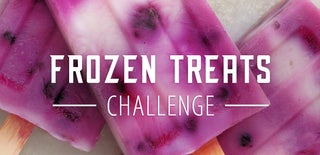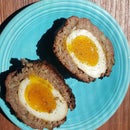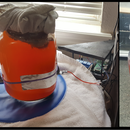Introduction: Blood Crystals
Wanting to add a splash of color when entertaining guests for drinks? Do you desire a slow-release flavor-bomb to tittilate your taste-buds over time? Wondering how the phenomenon of time arises in the fundamental laws of physics?
If so, then read on!
A Blood Crystal is a concentrated explosion of color and/or flavor imprisoned in a fortress of ice. You then unleash this explosion in your beverage of choice. A close relative of the Blood Crystal — the Bitter Ball — may be added to Seltzer (such as La Croix) for a refreshing punch of piquancy.
Supplies
A large (2.5 inch diameter) spherical ice-cube tray (isn't it funny how we still call it an ice cube even when it's not a cube?) I have the SVERES model, but there are plenty of decent models available.
A sterile syringe (preferably with a large diameter needle; inquire at your local Mountain Giants' pharmacy)
Food dye (preferably naturally derived, such as cochineal or turmeric — especially when kids are involved!)
Optional alternative for Bitter Balls: Angostura/Peychaud's/Underberg bitters
A freezer
Step 1: Prepare Your Water for Icing
Fill the ice-cube tray with water, a little (~1 ml) below the optimal filling line. For best results, use as high purity water as you can. Do not fill above the marked fill line. You'll thank me later.
If using tap water, you may want to boil the water beforehand. This releases most of the dissolved gases which come out of solution during the freezing process, which are largely responsible for reducing the clarity of the resulting ice. Lay the ice-cube tray in a flat part of the freezer. Move those frozen peas over.
Step 2: Prepare the Pigmentation and Ice
Draw 6 c.c. of dye or bitters into your syringe. The volume is equivalent to 6 ml, but most syringes give markings with c.c. (cubic centimeters). I use a small glass to hold the pigment for ease of drawing.
Check the ice-cubes after about two hours or less.
Although I have given the vague directive 'about two hours' here, the timing is critical, but is dependent upon your own freezer. You want the spheres to have formed a hard crust of ice, but a liquid core. Too iced over, and you'll have trouble piercing the ice layer. Too liquid, and the dye/bitters will dissolve throughout the whole shebang, diluting the entire experience.
Step 3: Add Pigmentation and Freeze
Each ice sphere of this size (2.5 inch diameter) takes a little over 100 ml of liquid water. Carefully inject 1 c.c. (1 ml) of dye/bitters into the center of the sphere. If the spheres are more frozen, you won't have much room, and you'll have pigment come back up near the top. Such is the price of experimentation. Results are guaranteed to be fun™ regardless.
Replace ice-cube tray into the freezer. After another few hours (again, depending on your freezer), you'll have the finished Blood Crystals.
Step 4: Serve and Enjoy!
To serve: place in a large enough glass tumbler, and add a clear beverage (or a cocktail that uses bitters as an ingredient, such as the Old Fashioned). Enjoy!
Step 5: But How Does This Relate to the Arrow of Time?
You might have caught my apparent throw-away comment at the beginning. What does this have to do with how physics treats time? Well, I'm glad you asked!
If you know anything of physics, you might know that (most of) the fundamental laws don't care much about what direction time goes in. Newton's Laws of Motion have no prejudice about what direction billiard balls go. Yet any fool can watch a video of a game of billiards and tell that the 'break' only goes in one direction! What gives? Why is it so impossible to uncrack an egg?
Well, it turns out that Blood Crystals are a perfect illustration of how.
Mix yourself a nice drink with a sphere of cochineal or Angostura and watch the brilliant color dissolve into your drink. You've just captured a 1 ml drop of pigment, and let it dissolve into the wider tasty beverage. What we mean by 'dissolved' is that the pigment particles get buffeted about by the larger volume of liquid, so that they're dispersed roughly evenly. From Newton's Laws' point of view, there are the equivalent of billions of molecular billiard balls colliding with each other every second.
As I mentioned, these laws themselves are time-reversible. You can run them backwards in time and they don't care. Yet it would be highly unnatural to see your drop of dye suddenly undissolve before your eyes. What's stopping it?
It turns out nothing, per se (a fancy way of saying 'as such'. It's a Latin phrase. It literally just means 'as such'. Casually throw in some Latin to make yourself seem much more authoritative). There is a chance you'll get all the dye particles clinging back together in a 1 ml clump.
Let's just do a rough calculation. No wait, let me do that for you to save your brain. In that 1 ml, there are roughly 1022 dye particles (i.e. a number with 22 zeros after it — it doesn't even matter what the starting number was). Let's say your beverage is about a cup, which is roughly 1024 molecules (again, it doesn't really matter what the number at the front is). There are only a few ways you can put that 1 ml of dye as a single clump in your glass (in the center, on the bottom, etc.). But there are plenty of ways you could have five dye particles on the bottom, and the rest in the center, etc.
There is a cool mathematical technique for calculating how many ways you can combine objects in certain ways: the combinatorial function. You can use this to calculate that there are almost 26 million different ways to make a five card hand in poker from a 52 card deck.
Using this to work out the number of ways we can dissolve our 1 ml dye clump into our beverage cup, we end up with a number that is beyond astronomical. The Universe is huge. There are something like 1080 fundamental particles in it, which is literally massive. Yet the number of states you'd call 'dissolved' is roughly 101034. In other words, the number of zeros after it is itself a number with 34 zeros after it. That's just crazy.
So, while technically possible, the chance of our pigment drop going from an ordered state (a single drop) to a disordered state ('dissolved') and back is so ridiculously improbable that we say it's surely impossible.
This concept is known as the Second Law of Thermodynamics ("entropy only ever increases or stays the same") and is currently though to be the main mechanism behind the Arrow of Time.
Cheers!
Step 6:

Participated in the
Frozen Treats Challenge












